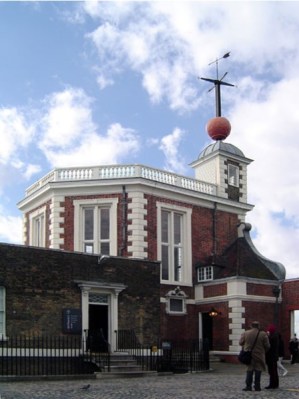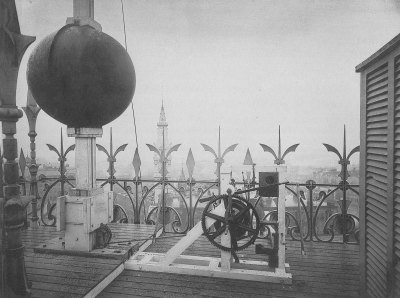If you watch the New Year’s festivities from New York, you know that they mark midnight with the dropping of a big, gaudy ball. You might assume this was just an arbitrary gimmick, but it turns out dropping balls has a place in the history of timekeeping, especially for ships at sea. The New York ball doesn’t work precisely the same, but it was clearly inspired by an ancient method of indicating the time.
Apparently, even the ancient Greeks used ball dropping to indicate time. But the modern ball got its start with [Captain Robert Wauchope], who installed one at Portsmouth, England, in 1829. The Royal Observatory in Greenwich got one in 1833, which you can see working in the video below.
The Problem to Solve

You want something tall so it can be easily seen. You also need something that clearly indicates the exact moment of the time mark, so that precludes something like raising or dropping a signal flag.
The Solution
[Wauchope’s] idea was to put a tower with a ball near a solar observatory with an accurate clock. Every day at noon, someone would sight the sun and determine the exact moment of noon, setting the accurate clock.
Then, at 1300, an hour later, you’d drop the ball. Everyone could set their clock to coincide with the ball drop. The moment the ball started falling was 1300.
About 1255, you’d raise the ball halfway. Around 1258, it would go to the top of the rod going through the center of the ball. The release would be at exactly 1300.
The American Take

Well, that’s not usually true in the United States. The first ball in the US was at the United States Naval Observatory in 1845. They would drop their ball at noon, exactly.
The Times Square ball first dropped on January 1, 1908. However, in another American difference, the stroke of midnight is when the ball reaches the bottom, not the instant it starts to drop.
End of the Ball
Of course, radio time signals made this technology obsolete. Still, there are about sixty balls still around, including many in Australia, the United Kingdom, and several scattered in other parts of the world. In the United States, you can find time balls at the Naval Observatory, the New York City Titanic Memorial, and the Plymouth Light in Massachusetts.
The Greenwich Time Ball located at the Royal Observatory in London still drops its ball every day at 1300, as you saw in the earlier video. The guide at Greenwich mentions that the expression “on the ball” relates to time balls, but we’ve also read it is a sports idiom, so we aren’t sure about that. Surprisingly, it isn’t the tallest Time Ball in England. That honor goes to the one in Hull, which, as you can see below, was recently restored and is once again operational. You can also watch a deep dive into the history of that particular ball.
Ships at sea have driven our time-keeping technology in many ways. Not to mention things like GPS or LORAN.
Featured image: “Working New Years Eve Social Media for NBC” by Anthony Quintano. Thumbnail: “Newyearseve loz batrch” by Alex Lozupone.
















Looks to be an excellent lightning rod.
I was watching the New York one and listening to WWV at the same time this new years. Turns out, the TV was about 5 seconds behind.
Digital TV can be really bad for that, what’s even worse is the delay can vary by brand and even different models of TV from one brand can have different lag
I guess that’s one way to intentionally drop the ball.
More seriously, thank you for the article. I learned something really unexpected today
Yeah, it’s not in the TV set… https://en.wikipedia.org/wiki/Broadcast_delay
My aunt and uncle used to live in France, and they had two TV’s: A French one (with SECAM reception) and a Dutch black and white one, attached to an ASTRA satellite dish.
During summers, we were often there and sometimes they would watch tennis with two tv’s on: the French for color picture, the Dutch one with scrambled images from some unpaid satellite channel, but with Dutch audio. There was about 5 seconds delay between the two.
Today is much worse. When I listen to my FM clock radio in my bedroom, I can switch it off, walk to my living room, switch on my media centre en start the web stream for the same channel and hear the last few words I also heard on the other radio, there is about 45 seconds of delay between them. This also means whenever I transition back to my bedroom and I don’t want to miss the program, I have to time it with a song or the ads before the news.
Doh, I did not mean to post that as a response. Sorry.
For digital cable or sat TV or whatever IPTV , the settop box or playback application has a buffer too, as does the the transmitting source. Then, there’s potential transcoding latency.
Most marinas still have a very accurately located position marker. Knowing your exact position makes determining exact time trivial (well, exact to the extent celestial navigation is exact). You will need to compute a transit but as I understand this was standard stuff. No need for a proper observatory and people to do it for you.
So no-one’s going to show us how the ball mechanism works?
An absolute guess, but I would suspect that it is entirely manual, and the mechanism. A flag pole mechanism would then make sense.
Our one goes UP not down!
Because when dropping under the force of gravity, it might get stuck on the pole.
Raising it is far more reliable.
God save the King!
I feel kind of disappointed that Americans are using this disgusting metric second and never came up with their own time measure like drop – roughly time that a drop of water take to fall from 7 feets. Something where day is divided into 10h each dovided into 660min that further divides into 12s and than it divises into powers of 2 just to finally go meteic.
OK – I had a pint too much. But I do feel that there is a place for essay or even book in Terry Pratchett style, based on that idea:)
It’s the other way around. We’re all using the imperial second.
Yes, the original proposal for the metric second was 1/100 of a metric minute which was 1/100 of a metric hour.